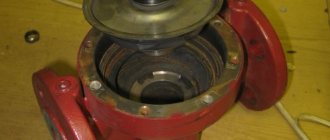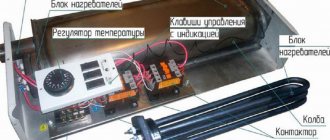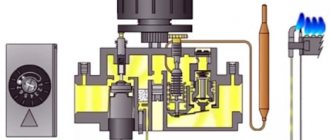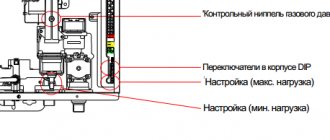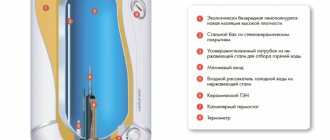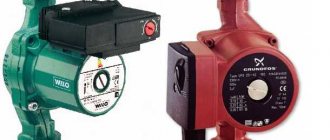Home » Automation and controls » Why and how automation is needed on old-style gas boilers
The newest models of gas boilers are characterized by high power and heating speed. However, their prices are steep, to put it mildly. You can try to use a more economical option and install new automation on the old boiler or fix the old one. The operating principle and automatic design of old-style gas heating boilers will be explained in this article.
…
- 1 Why do you need gas automation?
- 2 The principle of operation of automation on old-style gas boilers
- 3 Basic elements of automation
- 4 Flame and draft sensors
- 5 The most common automation malfunctions and methods for eliminating them
Types of boiler automation systems
Boiler automation is available in 2 types:
- Volatile, which operates only from the mains.
- Non-volatile, capable of operating in autonomous mode without supplying voltage to its actuators.
Advanced energy-dependent systems have the widest range of functions, from the boiler safety system to weather-dependent control, using the latest technological solutions and integration into the Smart Home system.
Non-volatile automation is more simplified and does not have a developed control system; it is used in places with an unstable power supply, as well as on coal-fired units. The main parameters that such a system controls are: water overheating, vacuum level in the firebox and the presence of a torch in the firebox.
Specifications
Let's look at the technical characteristics of the Zhukovsky AOGV 23 boiler:
| Options | Values | ||
| AOGV 23-2 Economy | AOGV 23-2 Universal | AOGV 23-2 Comfort | |
| Boiler type | Gas heating | ||
| Fuel type | Natural gas with the possibility of conversion to liquefied gas | ||
| Functions | Heating (coolant supply to the radiator system) | ||
| Efficiency | 89 % | ||
| Boiler power (max) | 23 kW | ||
| Gas consumption | 2.55 m3/h | ||
| Heated area | Up to 200 m2 | ||
| Coolant temperature | 50°-90° | ||
| Power supply | Absent | ||
| Boiler weight | 52 kg | ||
Automation system elements
Boiler automation elements are related to the power of the unit and the requirements imposed on them by state regulations. For municipal steam boilers DKVR (E), which are most widely represented in the central heating system with steam output from 2.5 to 20 t/h and saturated steam pressure of 13 and 23 amt.
Automation consists of two parts: safety and regulation. The first switches off the boiler when the set gas parameters, vacuum in the furnace, water level in the drum, steam pressure and T of feed water are exceeded, and the second maintains the specified operating parameters of the unit using actuators.
The boiler unit automation system operates on the basis of the AGAVA 6432 microprocessor device. The boiler unit control system includes:
- Controller AGAVA.
- Sensors for gas/steam/air/vacuum pressure, T of feed and network water, water level in the torch drum in the furnace.
- Cabinet KIRiA.
- Touch screen for operating personnel with indication and archiving of all measured parameters and operation of actuators.
- Power supply with emergency protection in the absence of stationary voltage at the control panel.
- Flow meters of fuel, steam, feed and network water.
- Actuators for gas, air, feed water and vacuum in the boiler, which must ensure the supply of the medium.
- Frequency converters for controlling fan and smoke exhaust motors.
Automation equipment for boiler rooms
Automation technical means:
- sensors of technological process parameters;
- actuators that move regulatory bodies according to commands in the desired direction;
- control equipment that processes information from sensors in accordance with the algorithms and programs embedded in it and generates commands for actuators;
- devices for selecting control modes and for remote control of actuators;
- means of displaying and presenting information to operational personnel;
- devices for documenting and archiving technological information;
- means of collective presentation of information.
All this technology has undergone revolutionary changes over the second half of the last century, not least thanks to the achievements of Soviet science. For example, pressure gauge instruments, widely used in measuring pressure, flow, speed and level of liquids and gases, as well as in measuring force and mass, have changed the physical principle of the sensing element.
Instead of a membrane that bends under the influence of force and moves the rod of an electromechanical transducer, they began to use a strain gauge method. Its essence is that some materials, when subjected to mechanical action, change their electrical parameters. A sensitive measuring circuit detects these changes, and a computing device built into the device converts them into a process parameter value.
Devices have become more compact, more reliable, and more accurate. And more technologically advanced in production. Modern actuators don't just accept "on" and "off" commands, as they did for many years. They can accept commands in digital code, independently decipher them, execute them and report on their actions and their condition. Control technology has evolved from tube regulators and relay-contact circuits to microprocessor-based control, logic and demonstration controllers.
Abroad, the use of such controllers in automation systems for various objects began a little earlier. A microprocessor controller is a computing device designed specifically to control a technological object located in its immediate vicinity.
The controller consists of the following blocks and devices:
- power unit;
- calculator;
- block for input of analog signals of different ratings with galvanic separation;
- device for inputting discrete active (in the form of voltage) and passive (in the form of a dry contact) signals;
- block for outputting analog signals of different ratings with galvanic separation;
- device for outputting discrete active and passive signals;
- an interface communication device for connecting the controller to the system information field.
Signal input and output blocks - blocks of the ICD group (communication devices with the object) - are all multi-channel, have from 8 to 16 channels. The controller is assembled for a specific task using the design layout method. The composition and number of USO blocks is selected based on the number of corresponding signals in the system. The computer block contains a processor, random access memory (RAM) and read-only memory (ROM). A library of algorithms is stored in ROM. Its composition covers almost all control tasks used in such systems - regulation, arithmetic calculations, dynamic transformations, logical actions.
Programming of controllers is carried out using the technological programming method. For modern controller models, this method is an assembly of a functional diagram of a control task on the monitor screen.
After a simple check for errors, the program circuit is loaded into the controller’s RAM. The intuitive accessibility of the method for traditional machine gunners contributed to the rapid and widespread spread of RemiKonts.
Principle of operation
The operation of energy-dependent thermal process automation systems is based on the analysis of data from the microprocessor unit from primary sensors. All service mode settings that determine the normal operation of the boiler unit are displayed on the main panel, which is installed either on the boiler itself for household units or AOGV, or on a remote control panel for industrial and municipal devices.
Modern boilers are equipped with special programmers that configure multi-day operating modes of the equipment, taking into account the weather forecast; the average outside air temperature is used to test operating modes.
In addition to sensors, the automatic system can be equipped with a controller integrated with the boiler bus for transmitting encoded signals and communication modules that guarantee communication with the consumer of thermal energy via the Internet network remotely using phones. Therefore, with such a high level of service, it is very important that the gas boiler is in good working order, and the automation repairs are carried out by a service center.
Device
The operating principle of the AOGV 23 boiler is based on heating the coolant using an atmospheric burner . Entering the tubular heat exchanger, the liquid reaches its maximum temperature, after which it is discharged into the heating system.
The movement of the coolant occurs under the influence of the upward thermal movement of heated layers, therefore the placement of all pipelines must be planned with a certain slope. To set the temperature to a given value, a three-way valve is installed, which mixes a certain amount of colder return water into the heated coolant.
Natural circulation is unstable and ineffective, so many owners install an external circulation pump to stabilize the system.
Electronics or mechanics
Modern boiler units, especially Western ones, are equipped with electronic boiler control systems, the cost of which reaches up to 30% of the total installation cost. The advantages of such a system are obvious; there is one drawback: it is afraid of unstable operation of Russian electrical networks. Therefore, it must be operated with reliable stabilizers and autonomous power supplies.
The range of regulation and control of the electronic system is practically unlimited: from pressure and temperature of the coolant to weather-dependent control of the heating unit.
In the safety system, the boiler will be turned off from the fuel supply at high/low gas pressure, torch separation, lack of vacuum in the furnace, low/high pressure and coolant temperature.
Mechanical actuators are also installed - a gas shut-off valve that is triggered by unacceptable gas pressure and a safety relief valve that protects the internal circuit of the boiler from high environmental pressure.
Mechanical systems operate only using mechanical valves and sensors that send a signal to the actuator or BURS ignition unit.
For example, the Buderus boiler unit is started by squeezing the gas valve washer, at the same time it opens and gas is supplied to the igniter. It heats up a thermocouple, which produces a current with enough voltage to drive an electromagnet to hold the valve open.
Next, the power of the boiler unit is set by the regulator, which allows gas to flow in the required volume with the operating pressure, and the heating process is controlled by a thermostat.
Features of AOGV
The abbreviation AOGV simply stands for gas-fired water heating apparatus. The number after the letters indicates the power of the model, that is, the AOGV 116 boiler is an 11.6 kW unit, respectively.
The technical characteristics of AOGV 11 6 3 indicate that the boiler is intended for heating a private residential house, garage or small utility room. The model is presented only in a floor-standing version; household units have a power ranging from 11-29 kW. The fuel used to operate the device is natural gas.
At the bottom of the boiler there is a heat exchanger, under which there is a gas burner. This is what heats the water. The unit can be converted
for the use of liquefied gas. High quality steel is used to make the device body. The heat exchanger is made of tubes, which ensures a high efficiency of the device.
In this video you will learn how to light a boiler AOGV 11.5
On the back there are two fittings for inlet and outlet. The top one works with a straight line, the bottom one with a reverse line. The upper part of the body is attached to the chimney; its diameter must exceed 12 cm. Manufacturers produce two types of boilers - single- and double-circuit boilers. The latter are intended not only for heating, but also for heating water.
Which automation is better?
Today, the boiler equipment market is oversaturated with proposals for boiler automation coming from both imported and domestic manufacturers.
The first ones are very expensive and capricious, they do not tolerate the operating conditions of Russian engineering networks, the second ones are less functional. The best automation for a boiler is always its own, that is, produced in a single configuration by the manufacturer.
It is there at the stands that it receives the correct settings with the operating modes of the unit. An equally important factor in boiler room automation is the manufacturer’s warranty, which must guarantee its operation free of charge for at least a year and replace the unit if it fails.
German
German automation for boilers Vaillant, Honeywell, AEG, Bosch is quite popular on the Russian market, which is explained by its excellent consumer quality, durability and reliability. High level of automation and protection. Recently, German manufacturers have established automation of condensing boilers, ensuring efficiency. almost 100%.
Italian automatics
EuroSIT 630 is considered the best Italian automatic system for gas boilers in the world. It is produced in full compliance with EU standards, but at the same time has a lower price than German systems.
The EuroSIT 630 boiler automation covers all parameters of the boiler operation, but is very sensitive to the operating parameters of the gas line and electrical network. For this system, it is mandatory to install input voltage stabilizers.
Russian
Recently, more and more boilers are being purchased with Russian automation systems, since they provide a good protection system and reliable boiler control at the lowest prices.
The experience gained with automation of processes in industrial boiler houses has been successfully integrated into the operation of household boilers using the latest technologies and developments from European manufacturers. Among the large number of Russian companies, especially the most popular are Neva-Transit and Lemax.
Advantages and disadvantages of the model
The advantages of Zhukovsky AOGV 23 boilers are:
- Reliability, simplicity of design.
- Independence from the power supply system.
- Simple and intuitive controls.
- Designed for use in Russian conditions.
- Designed to work in harsh climatic conditions.
- The service life is 14 years (or more).
- The cost of boilers is much lower than that of European analogues.
The disadvantages of the units should be considered:
- The heat exchanger of the units is made of steel, which is inferior in thermal conductivity to cast iron.
- The appearance of the boilers is inferior to European models.
- The mechanical automation of the boiler is quite weak.
- The dimensions and weight of the unit require installation in a separate room.
NOTE!
Most of the shortcomings are, to one degree or another, common to all atmospheric models, so they can be attributed to a specific design feature.
The best manufacturers of boiler automation and safety systems
The best manufacturers of automation systems for household boilers on the Russian market are considered to be the following companies: Aries, Orion, Eurosit, Nech st24 wpa 120, Honeywell and Atos wpa 120.
Aries
Automation for OWEN boilers operates using OWEN PLC controllers with TRM, which constitute a complex of protection and control of shut-off and control valves and valves, which ensures economical management of the fuel combustion process and energy efficiency of units, both single-circuit and double-circuit.
The devices are equipped with RS485/RS232 communication interfaces, allowing integration into a common automated system of several control and protection objects when operating on several heating boilers.
Orion
Automation "Orion" of mechanical type for gas fuel boilers. Equipped with an electric traction sensor and a piezoelectric ignition system. The boiler is protected in case of flame separation and low draft pressure. Automatic regulation occurs based on the low return coolant temperature parameter. In this case, based on a signal from the temperature sensor, the regulator valve increases the gas flow to the burner and, conversely, at a high water temperature in the heating circuit, the gas flow decreases.
Eurosit
Eurosit 630 is an Italian gas automatic for a boiler unit with a non-volatile valve, a modulation thermostat and a function for starting the burner device. It is put into operation manually by pressing the washer-regulator of the solenoid valve, after which the gas flows to the igniter.
After igniting the igniter, the temperature sensor creates a voltage sufficient to keep the valve open and reach operating power. The safety of the unit is ensured by cutting off the gas when the temperature of the coolant is exceeded, shutting off the gas to the torch, stopping the blower fan and the circulation pump.
Nech st24 wpa 120
Polish automation for a group of solid fuel and gas boilers, complete with control of the operation of a blower fan and an electric circulation pump for an in-house heating system.
The control unit is installed on the boiler body. The controller sets the temperature of the internal air in the room, then the boiler of a private house operates in automatic mode, the actuators are a gas valve-regulator, a blower fan and a centrifugal pump.
The control panel has an LCD display with visualization of coolant heating processes and boiler operating parameters.
Honeywell
Automation made in Germany by Honeywell is considered the most reliable and efficient, capable of adjusting the coolant in the temperature range from 40 to 90 C. The boiler is protected according to the following parameters: low gas pressure, flame separation and low coolant temperature.
The price of the kit is very high, which reduces its attractiveness. Therefore, the manufacturer recently began to produce economy class equipment.
Atos wpa 120
Another Polish automation system, mainly included with the Tech ST-24 solid fuel boiler with WPA 120 fan.
The microprocessor controller monitors and controls the heating temperature of the supply coolant, the operation of the blower fan and circulation pump and signals an emergency situation during boiler operation.
The ATOS command controller for gas boilers has a built-in ANTI-STOP system, which supplies gas to the boiler in the summer and automatically turns it on every two weeks for 30-50 seconds to prevent corrosion processes and jamming of the centrifugal circulation pump.
Cleaning methods
Cleaning is carried out in two ways: mechanical and chemical
Mechanical cleaning
The cleaning method is imperfect and involves mechanical action. Soot should be carefully removed so as not to damage the internal surface of the boiler and parts, which can subsequently lead to metal corrosion. Often the tools come with the boiler - these are pipe cleaners, brushes and scrapers. It is also possible to use air cleaning, when warm air is supplied under pressure.
Dry cleaning
It is recommended to apply cleaning agents while wearing PPE (personal protective equipment); rubber-based gloves are usually used, this will protect the skin from interaction with harmful substances. Chemicals clean not only soot, but also metal, which can further lead to its destruction. This method is best used on minor dirt and small areas of contamination.
Hydrodynamic cleaning
Hydrodynamic cleaning or how to clean soot from a diesel boiler.
It is used in boilers with a small thickness of contamination, as well as when speed of execution is required. Equipment for such washing consists of:
- pump and
- containers with water supplied under high pressure.
Thanks to this cleaning, soot and soot are removed quite quickly, but this method can only be used by specialists and is not recommended at home.
Booster cleaning
The procedure for flushing the heat exchanger with a booster (using the example of cleaning a Zhukovsky boiler from soot):
- First you need to disconnect the pipes from the heating system.
- Next, connect a booster hose to one of them to supply the reagent.
- We connect the second pipe to the second end of the hose. The spent reagent will be removed through it. This closes the system and the reagent will circulate through the pipes.
- After cleaning, the solution must be drained from the tube.
- Rinse the heat exchanger itself with sufficient water.
Booster is a device for chemical cleaning. Thanks to it, the reagents circulate autonomously.
During such cleaning, it is recommended to change the reagent several times, since the old one gradually reduces its properties. This method is most often carried out by specialists.
Gas boiler automation repair
If the boiler automation was purchased together with the boiler, it is configured at the manufacturer, then its operation is very reliable throughout the entire period stated by the equipment manufacturer.
Problems occur more often on European equipment, which are caused by the instability of Russian engineering systems. The most common breakdowns occur in the igniter, shut-off valve, electronic board and temperature sensors.
What you can do yourself
If the safety automation along with the boiler is under warranty, then it is better to contact a service center in case of any breakdown.
Many manufacturers in EU countries require equipment to be submitted for service only through branded centers and even after the end of warranty service. In these situations, it is not recommended to perform independent repairs. It is also unacceptable to change electronic control boards yourself.
The only thing that the user can repair on his own is to carry out testing and minor repairs to the mechanical part of the actuators and sensors.
Basic malfunctions and their repairs
Malfunctions of automatic gas boilers, which are most often encountered in practice, compiled from reviews of users and specialists in the field of maintenance and repair of household boilers.
Causes of the malfunction:
- The torch on the igniter does not light, the nozzle or gas filter is clogged, clean it from dirt and blow it out.
- A gas valve is defective, if it is under warranty, it is preferable to replace it with a new one at a service center.
- There is no contact between the cable and the traction sensor, the cable is disconnected and the contacts are cleaned.
- The draft sensor does not work; if the contacts are short-circuited and the cable is disconnected, the torch does not go out; it needs to be replaced with a new one.
- The thermocouple gives -EMF less than 0.3 mV; the thermocouple needs to be replaced.
Automation of boilers today is not a whim of the owner, but a requirement of standards for the safe operation of such units. It is achieved by using a variety of control and protection means: mechanical, hydraulic, pneumatic, electronic and computer, which are often combined depending on the level of automation and its cost.
The use of automatic systems in boiler operation increases their safety and ensures the most energy-efficient operating modes.
Varieties
There are three modifications of Zhukovsky AOGV 23 boilers:
- Economy _ Floor-standing unit with Russian automation, tubular heat exchanger. There is a temperature sensor.
- Station wagon. Italian SIT automatic equipment, modulated burner, coolant overheating sensor are installed.
- Comfort. In addition to all the options of the Universal models, the boilers have the possibility of remote control, a room thermostat, and protection against exceeding the coolant temperature.
Boilers of the Comfort modification can be distinguished from other varieties in appearance - they have a rectangular cross-section of the body, while Economy and Universal are round.
Start-up and operating instructions
The boiler is started after installation on a flat horizontal surface and connection of all communications:
- Gas supply.
- Forward and return lines of the heating system.
After installation, the system should be filled with coolant. The filling level is monitored using a signal pipe . The boiler is ignited using a piezo ignition unit or a lit match (Economy series).
IMPORTANT!
To start the boiler, you must first ventilate the room for 15 minutes. After this, open the gas tap, turn the knob to the “igniter on” position and push it in all the way. Wait in this position for 10-15 seconds, then press the piezo ignition button.
When a flame appears on the igniter, wait another 20-30 seconds, then release the handle . The pilot light should continue to burn. After this, you can set the required coolant temperature.
During operation, the user is not required to take any specific actions other than periodic cleaning of dust and soot.
Once a year you should invite a specialist to perform maintenance. For all problems, you must contact the warranty or service workshop .
Price range
The cost of the Zhukovsky AOGV 23 boiler depends on the specific model and ranges from 20-24.4 thousand rubles. This price does not include the chimney. When purchasing, you should immediately clarify the equipment of the unit so that you do not have to urgently look for the necessary components.
In addition, additional costs will arise for concluding a warranty agreement.
It is not recommended to neglect this action, since subsequently you can spend a much higher amount on repairs.
NOTE!
Many users rely on their own skills and knowledge, intending to repair the boiler themselves. It must be remembered that unauthorized actions with gas equipment may entail administrative liability.
For which rooms is it best suited?
AOGV 23 boilers are optimal for use in private homes, public or commercial premises. They require a separate room with ventilation, so installing the units in apartments is not recommended.
Also, production workshops with a large number of openings and technological hatches that disrupt the air exchange regime and create drafts are not suitable for operation. They often cause flames, which stops the heating system from working and creates the risk of gas leaks.
The best option is a separate room in the basement (ground) floor, with a window opening and an area of at least 8 m2.
